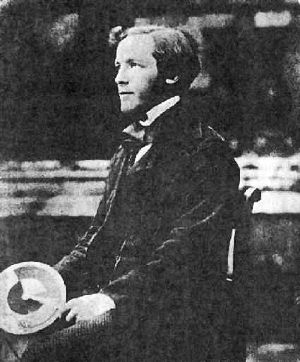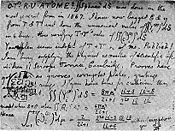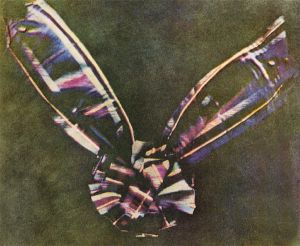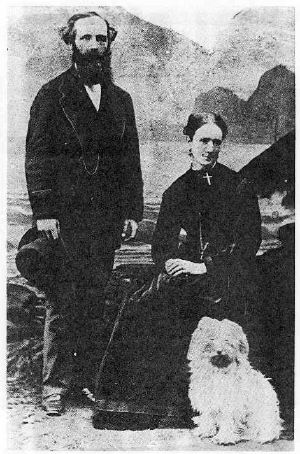James Clerk Maxwell
|
James Clerk Maxwell | |
|---|---|
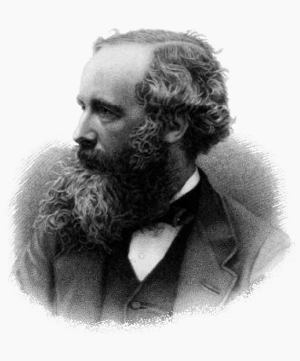 James Clerk Maxwell | |
| Born | |
| Died | 5 November, 1879 Cambridge, England |
| Residence | Scotland |
| Nationality | Scottish |
| Field | Mathematician and physicist |
| Alma mater | University of Cambridge |
| Known for | Maxwell's Equations, The Maxwell Distribution |
| Notable prizes | Rumford Medal, Adams Prize |
| Religious stance | Christian |
James Clerk Maxwell (13 June 1831 – 5 November 1879) was a Scottish mathematician and theoretical physicist. His most significant achievement was formulating a set of equations — eponymously named Maxwell's equations — that for the first time expressed the basic laws of electricity and magnetism in a unified fashion. He also developed the Maxwell distribution, a statistical means to describe aspects of the kinetic theory of gases. These two discoveries helped usher in the era of modern physics, laying the foundation for future work in such fields as special relativity and quantum mechanics. He is also known for creating the first true color photograph in 1861.
The majority of Maxwell's illustrious career took place at the University of Cambridge, where his investigations often made use of his mathematical aptitude, drawing on elements of geometry and algebra. With these skills, Maxwell was able to demonstrate that electric and magnetic fields travel through space, in the form of waves, and at the constant speed of light. Finally, in 1861 Maxwell wrote a four-part publication in the Philosophical Magazine called On Physical Lines of Force where he first proposed that light was in fact undulations in the same medium that is the cause of electric and magnetic phenomena.
Maxwell is considered by many, especially those within the field of physics, to be the scientist of the nineteenth century most influential on twentieth century physics. His contributions to physics are considered by many to be of the same magnitude as those of Isaac Newton and Albert Einstein.[citation needed] In 1931, on the centennial anniversary of Maxwell's birthday, Einstein described Maxwell's work as the "most profound and the most fruitful that physics has experienced since the time of Newton."
Biography
Early life and education
James Clerk Maxwell was born on June 13, 1831 in Edinburgh, Scotland, to John Clerk and Frances (née Cay) Maxwell. His birthplace, at 15 India Street, is now the location of the International Centre for Mathematical Sciences. It was at this time that physicist Michael Faraday was in the process of completing his work on magnetic induction, a concept upon which Maxwell would later build.
Maxwell grew up on his father's estate in the Scottish countryside. He was encouraged by his father to pursue his scientific and mathematical interests. Maxwell entered college at the age of 16 and eventually graduated with high honors in mathematics. All indications suggest that Maxwell had maintained an unquenchable curiosity from an early age. By the age of three, everything that moved, shone, or made a noise drew the question: "what's the go o' that?".[1] In a letter to her sister Jane Cay in 1834, his mother describes this innate sense of inquisitiveness:
He is a very happy man, and has improved much since the weather got moderate; he has great work with doors, locks, keys, etc., and 'show me how it doos' is never out of his mouth. He also investigates the hidden course of streams and bell-wires, the way the water gets from the pond through the wall...[2]
Recognizing the potential of young Maxwell, his mother Frances took responsibility for his early education, which in Victorian times was largely the job of the women of the house. She became ill — probably with cancer — and died in 1839. His father, John Clerk Maxwell, undertook the education of his son, with the aid of his sister-in-law Jane Cay, both of whom played pivotal roles in the life of James. His formal education began, unsuccessfully, under the guidance of a hired tutor. Not much is known about the man James's father hired to instruct his son, except that he treated the younger Maxwell harshly. His educational philosophy was founded upon coercion, often physical. James never responded well to the tutor's instruction; he chided his student for being slow and wayward. After considerable searching, John Maxwell sent James to the Edinburgh Academy. His school nickname was "Daftie", earned when he arrived for his first day of school wearing home-made shoes.
Maxwell was captivated by geometry at an early age, rediscovering the regular polyhedra before any formal instruction. Much of his talent went unnoticed however, and his academic work remained unremarkable until, in 1845 at the age of 13, he won the school's mathematical medal, and first prizes for English and for English verse. For his first piece of original work, at the age of 14, Maxwell wrote a paper describing mechanical means of drawing mathematical curves with a piece of twine and properties of ellipses and curves with more than two foci. This work, Oval Curves, was published in an issue of the Royal Society of Edinburgh, and although it shows the curiosity of Maxwell at a young age, it is important to note that the work itself was not mathematically profound. Unlike other great minds, such as Gauss, Pascal or Mozart, Maxwell was not a child prodigy. Rather, his genius would slowly mature.
Middle years
Maxwell left the Academy and began attending class at the University of Edinburgh. Having the opportunity to attend Cambridge after his first term, Maxwell decided instead to complete the full three terms of his undergraduate studies at Edinburgh. The main reason for this was that Cambridge was too far from home, and he would only have the opportunity to see his father twice a year. Another reason was Maxwell's concern for his future. He wanted to become a scientist, but jobs in science were rare at this time, and it would have been difficult to obtain a lecturing post at a university. Accordingly, Maxwell completed his studies at Edinburgh in natural philosophy, moral philosophy, and mental philosophy under Sir William Hamilton, 9th Baronet. In his eighteenth year he contributed two papers for the Transactions of the Royal Society of Edinburgh — one of which, On the Equilibrium of Elastic Solids, laid the foundation for an important discovery of his later life: the temporary double refraction produced in viscous liquids by shear stress.
In 1850, Maxwell left for Cambridge University and initially attended Peterhouse, but eventually left for Trinity College where he believed it was easier to obtain a fellowship. At Trinity, he was elected to the secret society known as the Cambridge Apostles. In November 1851, Maxwell studied under the tutor William Hopkins (nicknamed the "wrangler maker"). A considerable part of the translation of his electromagnetism equations was accomplished during Maxwell's career as an undergraduate in Trinity.
In 1854, Maxwell graduated with a degree as second wrangler in mathematics from Trinity (i.e. scoring second-highest in the final mathematics examination) and was declared equal with the senior wrangler of his year in the more exacting ordeal of the Smith's prize examination. For more than half of his relatively short life, he held a prominent position in the foremost rank of scientists, usually as a college professor. Immediately after taking his degree, he read to the Cambridge Philosophical Society a novel memoir, On the Transformation of Surfaces by Bending. This is one of the few purely mathematical papers he published, and it exhibited at once to experts the full genius of its author. About the same time, his elaborate memoir, On Faraday's Lines of Force appeared, in which he gave the first indication of some of the electrical investigations which culminated in the greatest work of his life.
From 1855 to 1872, he published at intervals a series of valuable investigations connected with the Perception of Colour and Colour-Blindness, for the earlier of which he received the Rumford medal from the Royal Society in 1860. The instruments which he devised for these investigations were simple and convenient in use. For example, Maxwell's discs were used to compare a variable mixture of three primary colours with a sample colour by observing the spinning "colour top." In 1856, Maxwell was appointed to the chair of Natural Philosophy in Marischal College, Aberdeen, which he held until the fusion of Aberdeen's two colleges in 1860.
In 1859, he won the Adams prize in Cambridge for an original essay, On the Stability of Saturn's Rings, in which he concluded the rings could not be completely solid or fluid. Maxwell demonstrated stability could ensue only if the rings consisted of numerous small solid particles, which he called "brickbats". He also mathematically disproved the nebular hypothesis (which stated that the solar system formed through the progressive condensation of a purely gaseous nebula), forcing the theory to account for additional portions of small solid particles.
In 1860, he was a professor at King's College London. In 1861, Maxwell was elected to the Royal Society. He researched elastic solids and pure geometry during this time.
Kinetic theory
One of Maxwell's greatest investigations was on the kinetic theory of gases. Originating with Daniel Bernoulli, this theory was advanced by the successive labours of John Herapath, John James Waterston, James Joule, and particularly Rudolf Clausius, to such an extent as to put its general accuracy beyond a doubt; but it received enormous development from Maxwell, who in this field appeared as an experimenter (on the laws of gaseous friction) as well as a mathematician.
In 1865, Maxwell moved to the estate he inherited from his father in Glenlair, Kirkcudbrightshire, Scotland. In 1868, he resigned his Chair of Physics and Astronomy at King's College, London.
In 1866, he statistically formulated, independently of Ludwig Boltzmann, the Maxwell-Boltzmann kinetic theory of gases. His formula, called the Maxwell distribution, gives the fraction of gas molecules moving at a specified velocity at any given temperature. In the kinetic theory, temperatures and heat involve only molecular movement. This approach generalized the previously established laws of thermodynamics and explained existing observations and experiments in a better way than had been achieved previously. Maxwell's work on thermodynamics led him to devise the thought experiment that came to be known as Maxwell's demon.
Electromagnetism
The greatest work of Maxwell's life was devoted to electricity. Maxwell's most important contribution was the extension and mathematical formulation of earlier work on electricity and magnetism by Michael Faraday, André-Marie Ampère, and others into a linked set of differential equations (originally, 20 equations in 20 variables, later re-expressed in quaternion- and vector-based notations). These equations, which are now collectively known as Maxwell's equations (or occasionally, "Maxwell's Wonderful Equations"), were first presented to the Royal Society in 1864, and together describe the behaviour of both the electric and magnetic fields, as well as their interactions with matter.
Maxwell showed that the equations predict the existence of waves of oscillating electric and magnetic fields that travel through empty space at a speed that could be predicted from simple electrical experiments; using the data available at the time, Maxwell obtained a velocity of 310,740,000 m/s. In his 1864 paper A Dynamical Theory of the Electromagnetic Field, Maxwell wrote,
- The agreement of the results seems to show that light and magnetism are affections of the same substance, and that light is an electromagnetic disturbance propagated through the field according to electromagnetic laws.
Maxwell was proved correct, and his quantitative connection between light and electromagnetism is considered one of the great triumphs of 19th century physics.
At that time, Maxwell believed that the propagation of light required a medium for the waves, dubbed the luminiferous aether. Over time, the existence of such a medium, permeating all space and yet apparently undetectable by mechanical means, proved more and more difficult to reconcile with experiments such as the Michelson-Morley experiment. Moreover, it seemed to require an absolute frame of reference in which the equations were valid, with the distasteful result that the equations changed form for a moving observer. These difficulties inspired Einstein to formulate the theory of special relativity, and in the process Einstein dispensed with the requirement of a luminiferous aether.
Control theory
Maxwell published a famous paper "On governors" in the Proceedings of Royal Society, vol. 16 (1867-1868). This paper is quite frequently considered a classical paper in the early days of control theory. (Please see publications below.)
Later years, death and afterwards
Maxwell also made contributions to the area of optics and colour vision, being credited with the discovery that colour photographs could be formed using red, green, and blue filters. He had the photographer Thomas Sutton photograph a tartan ribbon three times, each time with a different colour filter over the lens. The three images were developed and then projected onto a screen with three different projectors, each equipped with the same colour filter used to take its image. When brought into focus, the three images formed a full colour image. The three photographic plates now reside in a small museum at 14 India Street, Edinburgh, the house where Maxwell was born.
Maxwell's work on colour blindness won him the Rumford Medal by the Royal Society of London. He wrote an admirable textbook of the Theory of Heat (1871), and an excellent elementary treatise on Matter and Motion (1876). Maxwell was also the first to make explicit use of dimensional analysis, also in 1871.
In 1871, he was the first Cavendish Professor of Physics at Cambridge. Maxwell was put in charge of the development of the Cavendish Laboratory. He supervised every step of the progress of the building and of the purchase of the very valuable collection of apparatus paid for by its generous founder, the 7th Duke of Devonshire (chancellor of the university, and one of its most distinguished alumni). One of Maxwell's last great contributions to science was the editing (with copious original notes) of the electrical researches of Henry Cavendish, from which it appeared that Cavendish researched such questions as the mean density of the earth and the composition of water, among other things.
Maxwell married Katherine Mary Dewar when he was 27 years of age, but they had no children. He died in Cambridge of abdominal cancer at the age of 48. He had been a devout Christian his entire life. Maxwell is buried at Parton Kirk, near Castle Douglas in Galloway, Scotland.
The extended biography The Life of James Clerk Maxwell, by his former schoolfellow and lifelong friend Professor Lewis Campbell, was published in 1882 and his collected works, including the series of articles on the properties of matter, such as Atom, Attraction, Capillary Action, Diffusion, Ether, etc., were issued in two volumes by the Cambridge University Press in 1890.
Personality
From the start of his childhood, religion touched all aspects of Maxwell's life. Both his father and mother were devout churchgoers (Presbyterian and Episcopalian) and instilled a strong faith in their son. All information available suggests that neither in his adolescence, nor in his later years, did Maxwell ever reject the fundamental principles of his Christian faith. Ivan Tolstoy, author of one of Maxwell's biographies, remarked at the frequency with which scientists writing short biographies on Maxwell often omit the subject of his religion. It is impossible, however, to fully understand the man of James Clerk Maxwell without considering his faith. Tolstoy further suggests that such an "introspective, sensitive and lonely adolescent", would have relied on his religious beliefs for comfort.
As a great lover of British poetry, Maxwell memorized poems and wrote his own. The best known is Rigid Body Sings closely based on Comin' Through the Rye by Robert Burns, which he apparently used to sing while accompanying himself on a guitar. It has the immortal opening lines[1]:
- Gin a body meet a body
- Flyin' through the air.
- Gin a body hit a body,
- Will it fly? And where?
A collection of his poems was published by his friend Lewis Campbell in 1882.
Honours
Maxwell was ranked #24 on Michael H. Hart's list of the most influential figures in history and #91 on the BBC poll of the 100 Greatest Britons.
Homage
| “ | [The work of Maxwell]...[is] the most profound and the most fruitful that physics has experienced since the time of Newton. | ” |
—Albert Einstein, The Sunday Post[3] | ||
- The maxwell (Mx), a compound derived CGS unit measuring magnetic flux (commonly abbreviated as f).
- Maxwell Montes, a mountain range on Venus, one of only three features on the planet that are not given female names.
- The James Clerk Maxwell Telescope, the largest sub-mm astronomical telescope in the world, with a diameter of 15 metres.
- The 1977 James Clerk Maxwell building of the University of Edinburgh, housing the schools of mathematics, physics, computer science and meteorology.
- The James Clerk Maxwell building at the Waterloo campus of King's College London, in commemoration of him being Professor of Natural Philosophy at King's from 1860 to 1865. The university also has a chair in Physics named after him, and a society for undergraduate physicists.
- The £4 million James Clerk Maxwell Centre of the Edinburgh Academy was opened in 2006 to mark his 175th anniversary.
- James Clerk Maxwell Road in Cambridge, which runs along one side of the Cavendish Laboratory.
- The University of Salford's main building has also been named after him.
- James Clerk Maxwell was featured in the 1995 SNES game Tales of Phantasia as a summon that can aid the party in battle. His ability consisted of electromagnetic spheres that attacked the enemy.
Publications
- Maxwell, James Clerk, "On the Description of Oval Curves, and those having a plurality of Foci". Proceedings of the Royal Society of Edinburgh, Vol. ii. 1846.
- Maxwell, James Clerk, "Illustrations of the Dynamical Theory of Gases". 1860.
- Maxwell, James Clerk, "On Physical Lines of Force". 1861.
- Maxwell, James Clerk, "A Dynamical Theory of the Electromagnetic Field". 1865.
- http://www.zpenergy.com/downloads/Maxwell_1864_1.pdf
- http://www.zpenergy.com/downloads/Maxwell_1864_2.pdf
- http://www.zpenergy.com/downloads/Maxwell_1864_3.pdf
- http://www.zpenergy.com/downloads/Maxwell_1864_4.pdf
- http://www.zpenergy.com/downloads/Maxwell_1864_5.pdf
- http://www.zpenergy.com/downloads/Maxwell_1864_6.pdf
- Maxwell, James Clerk, "On Governors".From the Proceedings of the Royal Society, Vol. 16 (1867-1868) pp. 270-283.
- Maxwell, James Clerk, "Theory of Heat". 1871.
- Maxwell, James Clerk, "A Treatise on Electricity and Magnetism". Clarendon Press, Oxford. 1873.
- Maxwell, James Clerk, "Molecules". Nature, September, 1873.
- Maxwell, James Clerk, "Matter and Motion", 1876.
- Maxwell, James Clerk, "On the Results of Bernoulli's Theory of Gases as Applied to their Internal Friction, their Diffusion, and their Conductivity for Heat".
- Maxwell, James Clerk, "Ether", Encyclopedia Britannica, Ninth Edition (1875-89).
See also
- Main: Maxwell's demon | Maxwell's equations | Maxwell's theorem (a theorem in probability theory) | Maxwell-Boltzmann distribution | Scottish Enlightenment | Maxwell
- Physics: Scientific method | Wave-particle duality | Crookes radiometer
- Electromagnetism: Maxwell | Classical electromagnetism | Light | Photoelectric effect | Magnetic field | Radiation pressure | Electrons
- Radio waves: History of radio | Microwaves | Radar
- People: Peter Guthrie Tait | Oliver Heaviside | Albert Einstein | Hans Christian Ørsted | Heinrich Rudolf Hertz | Michael Faraday | Willard Gibbs | Joseph Stefan | Joseph John Thomson | Hendrik Lorentz | James Fitzjames Stephen | George Gabriel Stokes | Lewis Campbell | Fleeming Jenkin
- Schools: Trinity College, Cambridge | the University of Edinburgh | Edinburgh Academy | University of Cambridge
- Other: Analytical Society | Encyclopædia Britannica | Pi, the movie | Solar nebula | Venus | Photography | Colour photography
- Lists: List of Scots | List of physics topics | History of physics | List of physicists | List of Christian thinkers in science | Timeline of materials technology | Timeline of electromagnetism and classical optics | Timeline of processes | Timeline of solar system astronomy | Intellectual history of time | The 100 | 100 Greatest Britons |
- Commemoration: The James Clerk Maxwell Telescope is named after him, as are several streets in the United Kingdom.
ReferencesISBN links support NWE through referral fees
- ↑ Mahon, Basil (2003). The Man Who Changed Everything – the Life of James Clerk Maxwell. Hoboken, NJ: Wiley. ISBN 0-470-86171-1.
- ↑ Tolstoy, Ivan (1981). James Clerk Maxwell: A Biography. Edinburgh: Cannongate, 12. ISBN 086241010X.
- ↑ McFall, Patrick "Brainy young James wasn't so daft after all" in The Sunday Post, April 23 2006
External links
- Works by James Clerk Maxwell. Project Gutenberg
- Campbell, Lewis, "The Life of James Clerk Maxwell". 1882. [Digital Preservation]
- John J. O'Connor and Edmund F. Robertson. James Clerk Maxwell at the MacTutor archive
- Victorian Web's Maxwell
- 1911 Britannica Maxwell
James Clerk Maxwell Foundation
- The James Clerk Maxwell Foundation Including a virtual tour of the museum.
Maxwell's 175th Anniversary
- Maxwell Year 2006 Events planned to mark 175th anniversary of Clerk Maxwell's birth.
- James Clerk Maxwell Centre, Edinburgh Academy Opened in Maxwell's 175th anniversary year.
Song lyrics and poetry
- Rigid Body Sings song lyrics by Maxwell
- RPO — Selected Poetry of James Clerk Maxwell (1831-1879)
Maxwell - Christian/Creationist interpretation
- Maxwell and the Christian Proposition
- Maxwell, Molecules, and Evolution Explains the misuse of Maxwell's equations by Creationists
Photos
- http://www.edinphoto.org.uk/1_P/1_photographers_maxwell.htm - Photos and stories from the James Clerk Maxwell Foundation.
Mathematics
- Maxwell's Theorem
- Jack, Peter Michael, "Maxwell-equations: A Brief Note". Physical space as a quaternion structure - I.
- Glenlair Today
- Wolfram Research's Maxwell
Treatise On Electricity And Magnetism - 1873 Edition
Versions of Maxwell's 1873 treatise readable online
- A Treatise on Electricity And Magnetism - Volume 1 - 1873 - Posner Memorial Collection - Carnegie Mellon University
- Treatise on Electricty and Magnetism - Vol 1. (1873 Edition) - online readable version at openlibrary.org
- Volume 1 - 1873 - Internet Archive Mirror
- A Treatise on Electricity And Magnetism - Volume 2 - 1873 - Posner Memorial Collection - Carnegie Mellon University
- Treatise on Electricity and Magnetism - Vol 2. (1873 Edition) - online readable version at openlibrary.org
- Volume 2 - 1873 - Internet Archive Mirror
Supplementary material for understanding Maxwell's 1873 treatise
- On Quaternions, Or On A New System Of Imaginaries In Algebra by William Rowan Hamilton - PDF File
- Lectures On Quaternions by William Rowan Hamilton(Google Books)
- An Elementary Treatise On Quaternions by Peter Guthrie Tait - Archive.org
- Open Library Edition
- Introduction to Quaternions by Phillip Kelland & Peter Guthrie Tait(Google Books)
- Original Maxwell Equations - Maxwell's 20 Equations in 20 Unknowns - PDF
- A Dynamical Theory Of The Electromagnetic Field - 1865 Maxwell's 1865 paper describing his 20 Equations in 20 Unknowns - Predecessor to the 1873 Treatise
| Persondata | |
|---|---|
| NAME | Maxwell, James Clerk |
| ALTERNATIVE NAMES | |
| SHORT DESCRIPTION | mathematical physicist |
| DATE OF BIRTH | 13 June 1831 |
| PLACE OF BIRTH | Edinburgh |
| DATE OF DEATH | 5 November 1879 |
| PLACE OF DEATH | Cambridge |
ar:جيمس ماكسويل bs:James Clerk Maxwell bg:Джеймс Клерк Максуел ca:James Clerk Maxwell cs:James Clerk Maxwell da:James Clerk Maxwell de:James Clerk Maxwell et:James Clerk Maxwell el:Τζέιμς Μάξγουελ es:James Clerk Maxwell eo:James Clerk Maxwell eu:James Clerk Maxwell fa:جیمز کلرک ماکسول fr:James Clerk Maxwell gl:James Clerk Maxwell ko:제임스 클러크 맥스웰 hi:जेम्स क्लर्क माक्सवेल hr:James Clerk Maxwell id:James Clerk Maxwell it:James Clerk Maxwell he:ג'יימס קלרק מקסוול hu:James Clerk Maxwell mk:Џејмс Максвел nl:James Maxwell ja:ジェームズ・クラーク・マクスウェル no:James Clerk Maxwell nn:James Clerk Maxwell pl:James Clerk Maxwell pt:James Clerk Maxwell ro:James Clerk Maxwell ru:Максвелл, Джеймс Клерк sco:James Clerk Maxwell simple:James Clerk Maxwell sk:James Clerk Maxwell sl:James Clerk Maxwell sr:Џејмс Клерк Максвел fi:James Clerk Maxwell sv:James Clerk Maxwell te:జేమ్స్ క్లర్క్ మాక్స్వెల్ th:เจมส์ เคลิร์ก แมกซ์เวลล์ vi:James Clerk Maxwell tr:James Clerk Maxwell uk:Максвелл Джеймс Клерк zh:詹姆斯·克拉克·麦克斯韦
